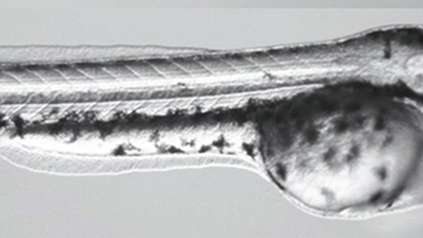Key protein behind brain asymmetry uncovered
A key protein shaping left-right asymmetry in the brain has been uncovered in a new study published by Science. The protein, called Cachd1, plays a crucial role in establishing the distinct neural wiring and functions on each side of the brain, find researchers from UCL, the Wellcome Sanger Institute, the University of Oxford and other collaborators.
By performing genetic screening experiments in zebrafish, researchers revealed that when Cachd1 was mutated, the right half of the brain lost its normal asymmetric development and instead mirrored the left side. This disruption caused abnormal neural wiring which would affect brain function.
This discovery sheds light on the genetic mechanisms underlying brain asymmetry, a phenomenon observed across many animal species, including humans. Understanding these processes could pave the way for better understanding human disorders where brain asymmetry is disrupted, such as schizophrenia, Alzheimer’s disease and autism spectrum disorders.
Despite their mirror-image anatomy, the left and right hemispheres of the human brain have functional differences that influence neural connections and cognitive processes like language. How these left-right differences in neural circuitry emerge is poorly understood.
Using zebrafish — a well-known model organism for brain development due to its transparent embryos — researchers set out to investigate how Cachd1 may influence brain asymmetry.
The team found that when Cachd1 was mutated, a region of the brain called the habenula1 lost its usual left-right differences. Neurons on the right side looked like those on the left, disrupting neural connections in the habenula and potentially affecting its function.
Protein-binding experiments revealed that Cachd1 binds to two receptors that allow cells to communicate through the Wnt signalling pathway – one of the most intensively studied pathways for cellular communication, playing vital roles during early development, stem cell formation and many diseases.
Further, Cachd1‘s influence appears to be specific to the right side of the brain, suggesting the presence of an unknown inhibitory factor restricting its activity in the left side. While the full details are yet to be uncovered, the evidence strongly suggests that Cachd1 plays a crucial role in establishing the differences between the left and right sides of the developing brain by regulating cellular communication specifically on the right side.
Future research will explore whether Cachd1 has other important functions involving the Wnt pathway.
“This was a very collaborative project that benefitted greatly from a cross-disciplinary approach – genetics, biochemistry and structural biology coming together to better understand the establishment of left-right asymmetry in the brain, as well as identifying a new component of an important signalling pathway that has many roles in health and disease.”
Dr Gareth Powell, co-first author of the study, former PhD student at the Wellcome Sanger Institute and now based at UCL Cell & Developmental Biology
“I am happy to see the publication of this highly collaborative study that has brought together many talented people with varied research interests and skills from multiple institutes. Together, the team have allowed us to make exciting new insights into both Wnt signalling and the development of brain asymmetry.”
Professor Steve Wilson, senior author of the study, at UCL Cell & Developmental Biology
More information
Notes to Editors:
This web story was adapted from the University College London.
- The habenula region of the brain regulates reward behaviours, stress responses, learning from negative experiences, sleep-wake cycles, and sensory processing. It is also linked to neuropsychiatric disorders like depression, addiction, and schizophrenia.
Publication:
G.T. Powell et al. (2024) ‘Cachd1 interacts with Wnt receptors and regulates neuronal asymmetry in the zebrafish brain.’ Science. DOI: 10.1126/science.ade6970
Funding:
This research was supported by Wellcome. For full funding acknowledgements, please refer to the publication.





